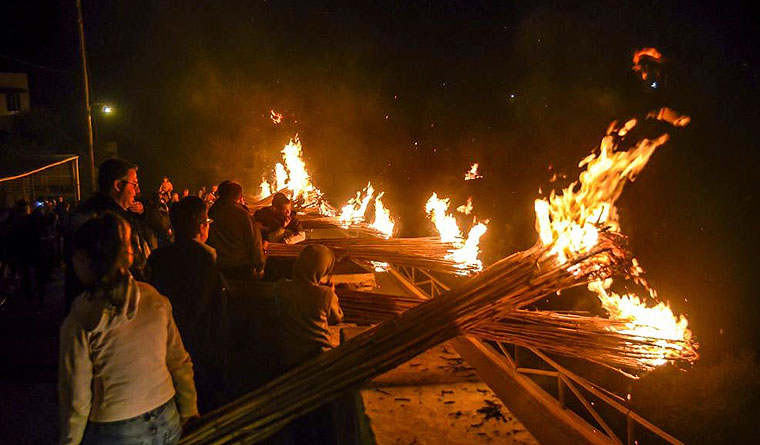
You are using the Free Edition of NaxosAPP. For extensive information on Naxos, GO PRIME with our comprehensive Greek Travel App featuring the full editions of Naxos and 25 more Greek islands & Athens.
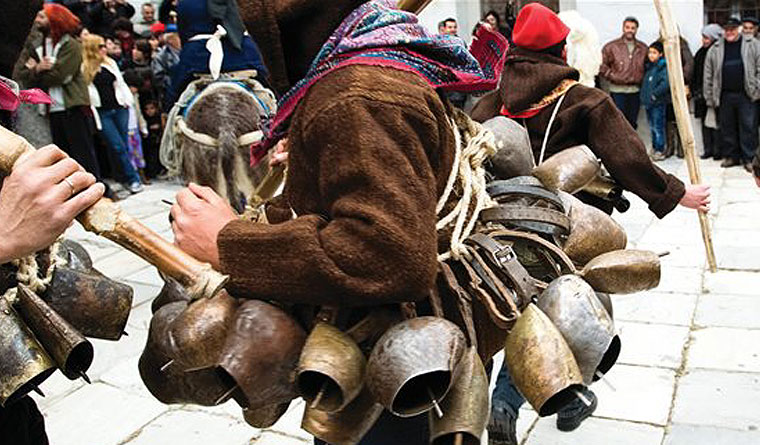
Naxiots certainly know how to celebrate. They party with communal verve and style whether it’s a religious holiday, the anniversaries of legendary dates, celebrating bountiful agricultural produce or contemporary cultural events. The key ingredients are usually great food, music, dancing, creative ideas and a deep sense of honouring the local culture in earnest. Bag-pipe instruments (tsabouna), violins and drums (doubakia) are an unfailing occurrence in the squares and courtyards of churches during celebrations and festivities. Here we list some of the most notable panigiria (religious festivals), cultural, agricultural and other events marked on the calendar.
PLEASE NOTE THAT DUE TO CORONA-VIRUS SOME OF THE FOLLOWING EVENTS MAY BE CANCELLED.
RELIGIOUS FESTIVALS
In addition to major celebrations such as Easter and Christmas, once a year each village celebrates the Saint whom the local church is named after (Panayiria as they are called in Greek). These religious festivities are the continuations of ancient customs which have thus survived to the present day. After a church service, the music begins and the celebrations involve feasting and dancing until the early hours of the next day. Visitors are welcomed with open arms. The festivals often take place in and around the taverns which are situated around the village square. Should you find yourselves at a festival, you will almost certainly be swept along in the merriment and find yourselves dancing. Don’t miss this rare opportunity!
The most important Panagiria (festivals) during the year are:
1st JANUARY: New Years Day or Proto Chronia. Traditionally a time to exchange presents. A special cake or Vassilopita is baked containing a coin. Whoever receives the coin is due a year of good luck.
EPIPHANY: On 6 January youths gather at the ports of the traditional villages of the island, and dive into the frozen Aegean water to get the cross (Stavro). Epiphany is celebrated with fanfare and ceremony.
GOOD FRIDAY: Throughout the country candlelit processions are held with icons and shrouded biers carried through the streets. On Naxos the feast of Panagia Agrokiliotissa takes place at Koronos village. At midday, at the church of Panagia Drossiani, the women share a specially made raisin-walnut bread with parishioners. In the village of Eggares, the route of the Epitaph is lined stalks of reed (known askalamia) that have been lit by the young boys of the village resulting in a solemn, powerful image.
HOLY SATURDAY – “Megalo Savato”. On the Saturday of the eve of Easter, the Naxiot family concentrates on baking and cooking for the dinner after the resurrection and the meal the following day. Candles are lit after midnight at the church from the ‘one true flame’, symbolising Jesus’ resurrection. They are are then carried back through the streets where they are used to mark a burnt cross above the front door to ward off evil spirits. People greet each other with the phrase “Christos Anesti” (Christ is risen), to which the reply “Alithos Anesti” is given. The Lenten feast is then broken with dyed red eggs and the special Easter Soup of “Magiritsa” traditionally made from lamb offal. Surprisingly this offal and lettuce soup actually tastes quite good and you should, given the opportunity, at least give it a try.
EASTER SUNDAY or “Kyriaki tou Pascha”. PARTY time! The traditional dish of stuffed baby goat and potatoes, known as batoudois the official Easter dish on the island, although there are a couple of variations based on what village you visit. In Apiranthos, for example, the basic stuffing, of herbs, onions and rice is enriched with raisins, while in Filoti bits of liver are added. The day is dedicated to feasting, drinking and dancing. Note that Easter in Greece is celebrated on the first Sunday after the full moon of vernal Equinox and is the most important Christian celebration of the year.
5th MAY: Saint Irene is celebrated in Kynidaro village.
20th MAY: On 20th May, the feast day of Agios Thalaleos is celebrated in Agios Thalaleos village.
23rd JUNE: Jumping over the fires – to make the evil spirits and the diseases go away – is characteristic of the feast of Agios Ioannis Klidonas. Housewives prepare salty pies, which are considered to have “magical powers”.
LATE JUNE: At the end of June, the village of Melanes celebrates its patrons Agioi Apostoloi (Saint Apostles) with a three-day festival which ends on 29th of June.
7th JULY: On 7th July, the feast day of Agia Kyriaki is celebrated in Potamia village.
8th JULY: On 8th July, the feast day of Agios Prokopios is celebrated in Agios Prokopios village.
14th JULY: On 14th of July locals celebrate the patron saint of Naxos, Agios Nikodeimos Agioritis. Celebrations take place mainly in Chora, but also in Glinado. After the church service there is a procession of the icon of the Patron Saint throughout the streets of the capital followed by a joyous and lively celebration with food, drinks and dancing.
17th JULY: On the 17th of July there are festivals in Agidia and Koronos villages dedicated to Agia Marina.
25th JULY: On 25th July the feast day of Agia Anna is celebrated in Agia Anna village.
26th JULY: Agia Paraskevi is celebrated in Kynidaro
27th JULY: On 27th July, the feast day of Agios Panteleimon is celebrated in Agersani village.
6th AUGUST: On 6th August the feast day of the Transfiguration of Jesus the Saviour is celebrated in the villages of Glinado, Damarionas, and Kourounochori.
15 AUGUST: Analipsi tis Panagias or Assumption of Mary. On the 15th of August each year Naxians commemorate the Assumption of the Virgin Mary and there are many celebrations throughout the island. The most popular celebrations take place in the village of Filoti at the 200 year old church, Panagia Fiiotiss, as well as in the village of Apiranthos were traditional dances are the highlight. Hundreds of people arrive to honour the icon of the Holy Virgin. Churches celebrate with a Holy Mass in the morning and panigiri (celebration) with food, music and dancing in the village square in the evening until early morning.
23rd AUGUST: On 23rd August, the feast day of the Holy Virgin’s novena is celebrated in Tripodes village.
29th AUGUST: On 29th August, one of the feast days of Agios Ioannis is celebrated in the villages of Apiranthos, Apollonas, and Agersani.
8th SEPTEMBER: On 8th September the feast day of Panagia Theoskepasti is celebrated in the villages of Komiaki and Potamia.
8th SEPTEMBER: Panagia Drosiani Moni.
14th SEPTEMBER: Holy Cross is celebrated in Tripods & Moni villages. A good harvest is important for the residents of Galanado, who in the feast day of Timios Stavros leave outside the church a few seeds wrapped in a cloth for the priest to bless.
20th OCTOBER: St. Artemios is celebrated in the village of Kynidaro.
21st NOVEMBER: The Eisodia of Virgin Mary in the village of Akademi.
6th DECEMBER: St. Nicholas is celebrated in Kynidaro village.
25 DECEMBER: Christougena – Christmas Day. Whilst less important than Easter in Greece this is still a day for religious services and feasting. Nowadays Christmas throughout Greece has been influenced heavily by Western traditions and everywhere you will find strings of lights and Christmas decorations, although, no doubt due to Greece’s close relationship with the sea, often boats, not trees are the centrepoint of Christmas decorations. During the Christmas period children sing carols and are rewarded with small gifts of money.
NAXOS CARNIVAL
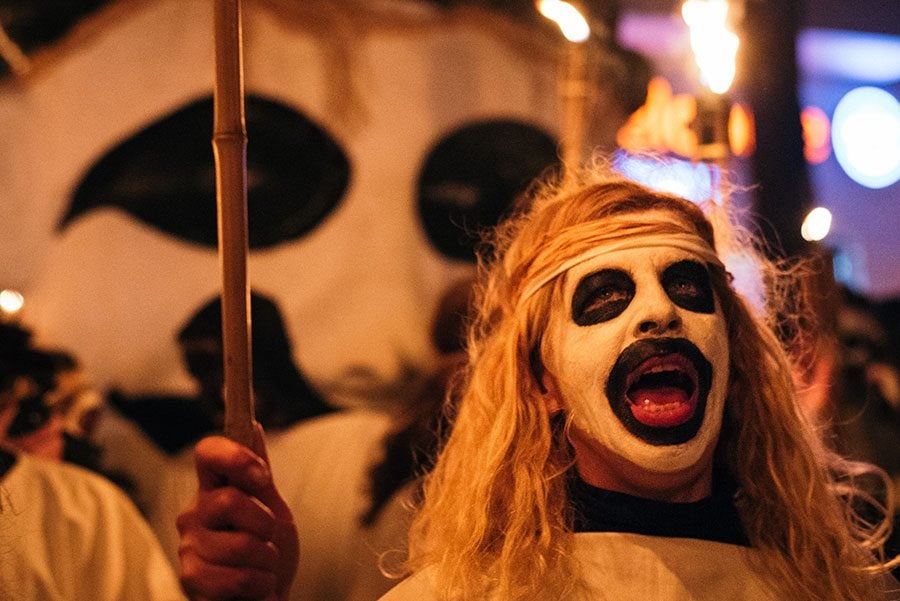
Carnival traces its roots to the ancient cult of Dionysus, god of wine and theatre, and Christianity silently incorporated the dominant celebrations in the religious calendar as a last wild enactment before the pious 40-day fast and preparation for Easter. Over the last few years a large effort is being made by local authorities and voluntary teams to revive the carnival festivities on Naxos to their former glory, and during the last weekend of the Carnival (the weekend before Clean Monday) various events take place throughout the island:
On the last Friday night of Carnival the custom of Methydotia is presented in Naxos Town representing the philosophy and times of the god of wine and theatre, Dionysus. Musically the event is enthusiastic and wild, and men dressed as satyrs and women as Maenads present scenes from the life of Dionysus and his followers.
On Saturday night – with the majestic Portara (Temple of Apollo) as backdrop, the Lampadifories (Torchbearers) parade starts in the Kastro and continues to the beach of Naxos Town. With faces painted black & white and dried grass in their hair, wrapped in white sheets and holding lighted torches, the Torchbearers flood the streets of the Venetian Castle with incomprehensible screams and shouts and eerie drum sounds. In the end their carnival king ends up in the fire with the Lampadifers forming a circle around him, dancing and singing in a representation of ancient worship. Rakomelo (an aperitif) and wine are offered at the end of the parade in the central square where traditional music played on the ancient instruments of tsambounes and toumbakia continues to entertain. Visitors are welcome to join in the traditional Naxian dancing, food and song as the celebration continues until the early hours of the morning.
On Sunday noon, the colourful and festive Carnival parade takes place in Chora (Naxos Town). This is the closing event of Naxos Carnival.
In addition to the events of Chora, many villages around the island revive their own traditions on the last Sunday of Carnival continuing into Clean Monday. Violins, bag-pipes (tsabouna) and drums (doubakia) are heard throughout the squares and courtyards of churches in many villages of the island. The feast continues into Clean Monday.
In villages such as Danakos, Apiranthos and Koronos, young men wearing hoods and bells (koudounati) and holding a phallic symbol (soba) create a deafening noise in the alleys of the village – a custom signifying the arrival of spring and meant to drive the evil spirits away. The procession ends at the village square where the koudounati join more dressed-up characters and begin the dancing and song that lasts well into the night.
Similar customs of kordelati and foustanelati take place in the villages of Galini and Eggares on Clean Monday. Young men wearing coloured ribbons and the national Greek costume of foustanela form groups (bairakia) and, led by the standard-bearer (bairaktaris) who holds a thick cane with a coloured cloth, head for the neighbouring villages where they invite local women to dance to the tune of violins and lutes. Reciprocating, the women offer the men delicacies and wine. In the old days the custom also functioned as a means of facilitating the meeting of young people from different villages and resulted in many marriages. But it is still observed in earnest relayed from one generation to the next.
CULTURAL & OTHER EVENTS
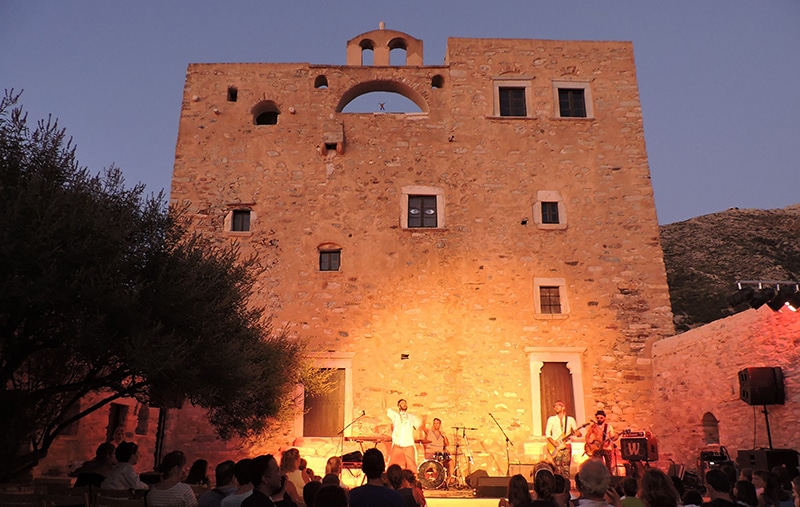
AXIA INTERNATIONAL MUSIC FESTIVAL
The Axia International Festival takes place in mid-August every summer in the atmospheric square of Halki, one of the most beautiful villages of Naxos island. This festival is a special meeting point for music and art lovers. In fact, distinguished musicians from all over the world are invited to play their music in the central square of Halki. Among the musicians who have played in the Axia Festival are the pianist-composer Philip Mayers, the singer-pianist Keiko Borjeson and the singer/guitarist Hans Limburg.
The Axia Festival usually lasts for 3 days. It is organised by potter Katharina Bolesch and craftsman Alexander Reichardt who run the gallery ‘Fish and Olive’ in Halki. Apart from music concerts, the festival occasionally includes art exhibitions, lectures, and special environmental activities. This is a non-profit festival with free entrance. It is sponsored by the Axia International Friends Group and private contributions.
DIONYSIA FESTIVAL
The Dionysia Festival honours God Dionysus and is one of the best-known festivals on Naxos. Held during the first weekend of September each year, it includes concerts, theatrical performances, art exhibitions and a plethora of other events which are crowned with a wine festival in honor of God Dionysus.
BAZEOS FESTIVAL
The Naxos Festival first began in the summer of 2001 and takes place every year since in the restored Bazeos Tower in the centre of the island. The aim of the festival is to promote the local culture through cultural events, musical concerts and art exhibitions, and also to encourage the interaction between national and international cultures. Organised every summer from July to September, the Naxos Festival attracts artistic and scientific figures from around the world. Apart from cultural events, it also presents lectures, workshops, and seminars on various issues.
Bazeos Tower where the festival takes place, was constructed around 1600. Originally and until the 19th century it functioned as a monastery of the Holy Cross. When the monastery was abandoned the tower became the property of the Greek State. For many years it then served as residences and workshops of ceramists, but in the late 19th century it was bought by the Bazeos Family. In the late 20th century the tower was restored to house this cultural venue.
THE ELAIA ARTS FESTIVAL
The Elaia Arts Festival held at Kaloxylos early in August, offers visitors the opportunity to become acquainted with artists through their work. Sculpture, photography, live music, theatre, as well as dance performances feature on the events agenda. The festival which aspires to establish itself as one of the main events on the island’s cultural calendar, offers visitors days dedicated to the arts, full of imagery, sound, colour and music.
DOMUS FESTIVAL
The Domus Festival at the Venetian Museum, one of the most charming mansions of Kastro, hosts various musical events, including jazz, classical guitar, and piano performances. Concerts here, also featuring local artists, take place between April and October held in either the garden or the basement, depending on the season and weather. Tickets should be booked in advance at the museum (+30 22850 22387) and include a glass of local wine or kítron.
THE FESTIVAL OF DEMETRIA
The Demetria event, a cultural institution on Naxos, is held every year during the first week of August at Sagri, a traditional village and location of the archaeological site of the Temple of Demeter, a sanctuary built in honour of the the goddess of agriculture. It features mostly agrotourism stalls where visitors may try goods produced an grown on the blessed land of Naxos. Concerts and theatrical plays take place in the courtyard of Agios Eleftherios, a 17th century monastery, while art exhibitions by established artists are held inside.
Photography exhibitions take place along the villages delightful alleys.
RAKI DISTILLERY FESTIVAL
The Raki (pronounced rakee) Distillery Festival is one of the most noteworthy events on the island celebrated annually in the month of September/October in the Municipality of Drymalia. It is also known as the Rakitzo festival. It is a festival that involves a great feast for the people of Naxos as soon as the raki distillate is collected.
Late September when the grape harvest is over, villagers throughout the island gather to take part in the Raki Production. The distillation process accompanied by hearty feasts, the fragrance of the produced spirits and aromas of the baked goat meat and quinces spread all over the island. Once the first distillate is gathered, a drinking of spree begins that is regarded as a custom of the Rakitzo festival.
ANNUAL WINE FESTIVAL
Held at the end of every summer in Komiaki village, the annual Wine Festival offers visitors a great opportunity to try Naxos’ local wine, accompanied by delicious assorted small dishes (meze or mezedes in plural), mostly fish and seafood, all topped off by dancing to live music performed by local artists.
The event includes the foot pressing of grapes at a traditional wine press, and talks about local varieties and production method, so that besides wine tasting visitors may be informed about the unique qualities of Naxos wine.
Known also as the island of Dionysus, residents cultivate 5.646 acres of vines producing a variety of tasteful and fragrant wines.
OLIVE OIL FESTIVAL
The annual olive oil festival brings many visitors to the traditional oil mill of Damalas village to watch the traditional production of olive oil and celebrate with the locals.
Olive trees are to be found all over Naxos and the importance placed by locals on their cultivation is tremendous. The number of olive trees on Naxos amount to over 270,000. The majority of these are located in the Tragea valley. The festival allows visitors to observe the olive oil extraction process. This traditional process is turned into a festival in the village of Damalas. It is usually held between late January and early February. Once the work is done, local culinary delights and wine are offered to all, accompanied by traditional music.
GRAVIERA FESTIVAL
Approximately 1.000 tons of graviera cheese is produced every year on Naxos, and this wonderful cheese has been awarded Protected Designation of Origin (PDO) status.
Because of its rich flora and the perfect climate conditions, Naxos has about 4.500 cattle and 110.000 goats and sheep. The produced varieties of cheese and meat are well known for their excellent quality.
The Graviera festival takes place in September organised by the Union of Rural Cooperatives and aims to further promote this renowned product.
FISHERMANS FESTIVAL
The village of Apollonas hosts an annual Fisherman’s Festival on June 28, attracting visitors and villagers from across the island. The festival begins with a service at Agios Ioannis (St John) church, followed by the blessing of waters and fishing boats. Next on the agenda is a joyous and lively celebration with live traditional music featuring some of Naxos’ leading artists. Food served is of course mainly fish and seafood. The wine flows in abundance and the celebration continues until the morning hours.
POTATO FESTIVAL
The Potato Festival is held every August with great success at Kapares, Agia Anna.
The Union of Rural Cooperatives in cooperation with the cultural association of Saint Arsenios and the Region of South Aegean organise this fabulous festival. More than 4.000 people participate every year enjoying dancing with traditional music and tasting many recipes based on potatoes.
Naxos is well known for its delicious potatoes, cultivating almost 17.000 tons every year and 1.500 tons of potato seeds.
KOUZINOMAGIREMATA (Cookery contest)
At the end of July each year, women in Danakos organise a cookery contest and display of their homemade, mostly traditional delicacies under the centenarian plane tree by the water spring (Pigi) plateau. Connoisseurs award prizes to the winners.
A festive traditional feast follows with music by local performers.
MUSIC & DANCE
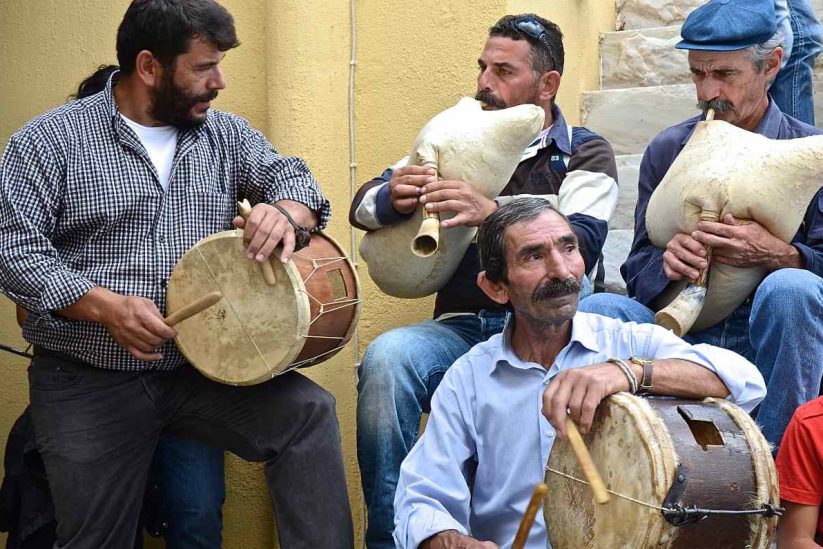
Out of all the Cycladic islands only Naxos has such a lengthy and lively tradition in music and dance.
Ancient artifacts from as far back as the pre-Cycladic period (3rd millennium BC), depicting musical and dance illustrations stand as proof of Naxos’s uninterrupted and age-old connection with dance and music. Amongst various music and dance-related antiquities that have been discovered, historian and writer Nikos Kefalliniadis makes reference to a dance performance depicted on an ancient stone bed found at the Korfi t’Aroniou hilltop in the Apiranthos area, as well as the “harpist” and the “flutist” of Keros, an island – nowadays uninhabited – about seven n.m. southeast of Naxos. And in her writings, Dialechti Zevgoli-Glezou, a poet from Naxos, illustrates the uninterrupted connection over the ages between the everyday lives of Naxos islanders and music and dance:
“Every house would be a dance venue, ceaseless feast and celebration.
We would dance in the fields, squares, even streets.
Even the smallest attic was not left quiet,
We danced and threw flowers around, lissome lads and lasses.”
Despite the wider impact of modern day lifestyles and the invasion of new musical tastes, Naxos’s traditional form of dance music remains very much alive.
Axiotakia (Axiotes, the inhabitants of Naxos are colloquially called) say that dancers come out of their mother’s womb, and it is no coincidence that large musical families of Naxos have kept the island song alive (Konitopoulos, Hatzopoulos and Koukoularides come from Naxos). Today in the villages of Kinidaros, Komiaki, Koronos and Aperathos, there are entire families of music singers, organists and lyricists.
Folk musical instruments associated with Naxos throughout time are the souvliari (a shepherds pipe or flute), the dumbaki (drum), the jambuna, the violin and the lute. The souvliari was used at festivals till the early part of the 20th century and the tzambouna was the main instrument used in the local festivals up until 1920-1930 when the violin, which came to Naxos from Asia Minor, took over. These instruments began giving way to the combination of clarinet, violin, and lauto, a traditional stringed instrument. Violin and lauto eventually became the foremost instruments heard at the islands celebrations and feasts.
The evolution of the island’s folk songs may be divided into three categories, according to Stavros Spiliakos, an academic and researcher specializing in traditional Greek dance:
– The pre-Naxos tradition: the free-verse, narrative and non-rhyming Akritika – legends of the Byzantine era-love stories, and Moraitika (Peloponnesian) songs
– The Naxos tradition–songs developed through social change and assimilation by local artists.
– The post-Naxos era–the style developed after the War period (1940) to today.
Naxos’ dance styles may be listed as: syrtos (slow or fast); ballos (slow or fast) –a natural evolution and result of various syrto dances; vlacha; dirla; vintzilleadistikos; kotsatos; and nikindres. However, a variety of other styles originating outside Naxos, such as Kalamatianos, Paros’s Ageranos, tsifteteli, chasaposerviko, and zeibekiko are often danced at festivities on the island, as are foreign dances, including tango and waltz.
Generally speaking, dance proceedings at celebrations on the island begin with slow-paced styles, gradually liven up with faster, bouncier styles, and eventually wind up with the ballos, a style danced by couples, face to face.
Feasting and dance, which has always been intertwined with life itself for islanders serve as a form of entertainment, expression of feelings, and an antidote to life’s bitter times.
If you are given the opportunity to be at an island festival, you will discover the beauty of the Naxian music and dance tradition.
